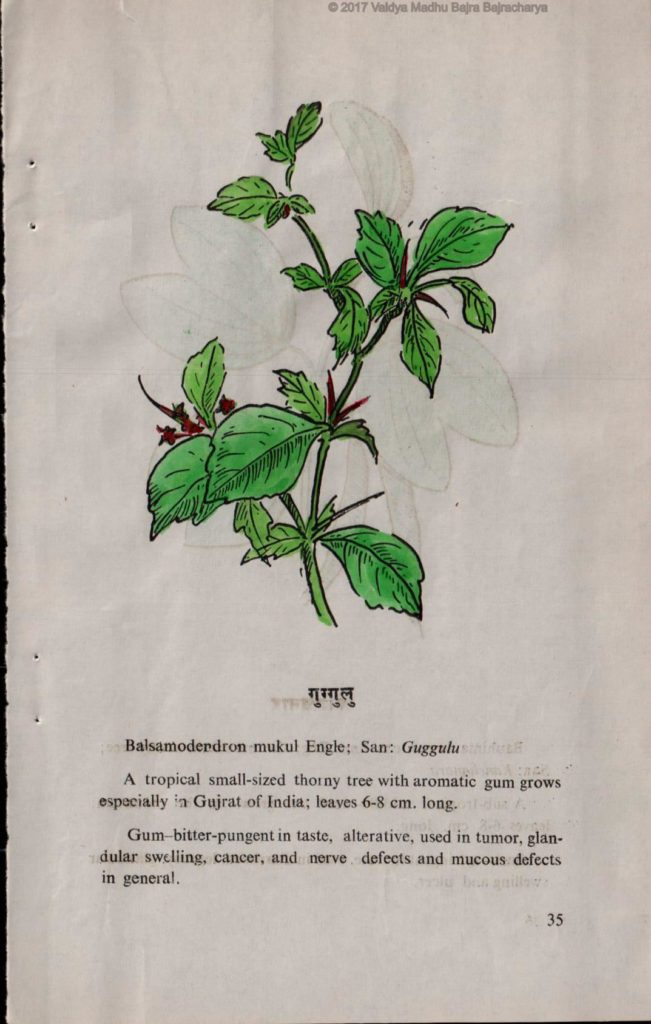Latin: Commiphora mukul, Balsamodendron mukul
Sanskrit: Guggulu
WHAT IT DOES: Guggul gum is bitter and pungent in taste, and hot in action. It is a longevity tonic that stimulates metabolism and the breakdown of mucous, tumors, fat and cysts.
RATING: Gold
SAFETY ISSUES: Do not use during pregnancy. Excess use of concentrated guggulipid may cause headache, mild nausea, skin dryness and vomiting (Singh et al., 1994). May cause reduced bio-availability of the drugs diltiazem (cardizem) and propranolol (Dalvi et al., 1994).
STARTING DOSAGE:
• Concentrated dried extract: one to two grams two times per day
• Standardized lipid: 500 mg (yield=25 mg guggulsterone) three times per day
Note: use only prepared extracts

Guggul gum has been used in Ayurvedic medicine for centuries to treat abnormal growths, tumors, cysts, arthritis, glandular swelling, cancer, inflammation, and as a rasayana for promoting long life and health. It is so important in TAM healing that it has its own group of compound medicines listed in the TAM Materia Medica. Two of the most well known medicines are yogaraja guggul and kaishore guggul. Yogaraja guggul is used to treat enlargement of the abdomen, peritonitis, rheumatism, neurasthenia, sciatica, and, most importantly, degenerative nervous system diseases (Vata). It also has significant anti-inflammatory properties (Pandley et al., 1996). Kaishore guggul is used to treat weak digestion, constipation, arthritis, boils, diabetic ulcers, abdominal tumors, leprosy, leukemia, psoriasis and, most importantly, all minor or complex inflammation-related diseases (Pitta).
Guggul gum has been popular in the West since researchers discovered its significant cholesterol-lowering properties in human trials (Nityanand et al., 1989). The gum can be separated into base, acid and neutral fractions. The neutral fraction contains most of the cholesterol-lowering activity, while the acid fraction contains some anti-inflammatory components. It is my opinion that guggul should not be used by itself in this concentrated form, but is best used as part of complex formulations. Concentrated dried decoction extracts focusing on the cholesterol-lowering aspect are now being mixed with other cholesterol-lowering herbs and nutrients (such as ginger root and niacinamide) and sold as alternatives to Western drugs. This entire idea has serious problems, not only due to the flawed cholesterol/heart attack hypothesis, but also because this idea is an inappropriate mixing of Western goals of targeting specific blood parameters with herbal actions discovered in the laboratory.
Guggul gum in its traditional form is almost always used in combination with triphala and/or guduchi stem (Tinospora cordifolia). Both of these have strong anti-poison, anti-oxidant, and anti-inflammatory properties. TAM doctors also divide guggul into two types, new and aged, and prescribe them differently. The aged form has been considered a major anti-cancer herb since ancient times.
Research Highlights
• In human trials, a combination of guggul gum and puskaram tuber (Inula racemosa) proved superior to nitroglycerin in reducing the chest pain and dyspnea associated with angina (Miller, 1998; Tripathi et al., 1988).
• Guggul may also have value in acne treatment. In one study, a majority of patients with serious nodulocystic acne experienced a progressive reduction (about 60-70%) in lesions when treated with guggulipid, results comparable to patients who received tetracycline (an antibiotic) treatment. The researchers noted that patients with very oily skin responded remarkably better to guggulipid than the antibiotic (Thappa et al., 1994).
• Clinical studies done in 1956 by Chopra showed guggul’s ability to elicit significant improvement in psoriasis cases (Pandley et al., 1996).
• Guggul gum may also have mild thyroid-enhancing activity due to its effects on fats (Panda et al. 1999).
